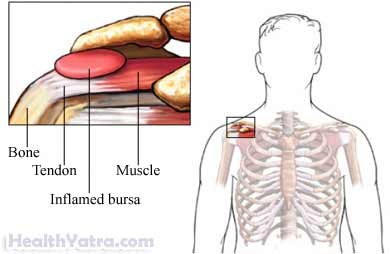Definition
A bursa is a thin sac. It lies between bone and soft tissue near certain joints. A healthy bursa allows smooth movement of soft tissue over the bone. Bursitis is inflammation of a bursa. This inflammation can make it painful to move the nearby joint.
Bursitis occurs most often in the:
- Shoulder
- Elbow
- Knee
- Hip

Causes
Bursitis may be caused by:
- A blow to an area containing a bursa
- Repetitive stress on the bursa
- Infection in bursa
- Long periods of pressure on joint—leaning on elbows, sitting or kneeling on hard surfaces
- Medical conditions that cause inflammation in joints such as rheumatoid arthritisor gout
If the stress is not relieved, bursitis can become chronic (long term) condition. This can make permanent changes of the bursa.
Risk Factors
Factors that increase your chance for bursitis include:
- Repetitive motion activities when done to an extreme (for example, swimming, running, or tennis)
- Job that requires:
- Repetitive motions such as hammering or painting
- Long hours in one position such as a carpenter kneeling
- Contact sports
- Sporting gear that is too tight
- Puncture or deep cut that involves bursa
Symptoms
Symptoms of bursitis include:
- Pain in the area
- Swelling
- Reddened skin
- Warmth around the area of the bursa
- Decreased motion of the nearby joint
- Decreased function of the nearby limb
Diagnosis
The doctor will ask about your symptoms and your physical activities. The painful area will be examined. You may have an x-ray.
Treatment
Bursitis treatment will focus on decreasing the inflammation and pain. The main step is to stop the activity causing the pain. You will be asked to rest the area involved and protect it from trauma. Your doctor may also recommend:
- Applying ice to the area in the first few days
- Anti-inflammatory medications such as ibuprofen or naproxen
- Crutches or cane if knee or hip bursitis needs support
If the bursitis is very painful, your doctor may recommend a corticosteroid injection. These injections have short-term benefits and some risk. They may be limited to conditions that interfere with daily activities.
Chronic bursitis may need more aggressive treatment. Additional steps may include:
- Physical therapy—sessions may include exercises and heat therapy
- Surgery—only if all other treatments are not effective
Prevention
The following steps may help to prevent bursitis:
- Do not overdo sports and other activities.
- When doing a new activity, gradually increase the intensity and duration of activity.
- Make sure you perform activities correctly.
- Wear properly fitting, protective pads if you play contact sports.
- Use proper safety equipment at work.
- Work with an ergonomic specialist to improve work related activities.
